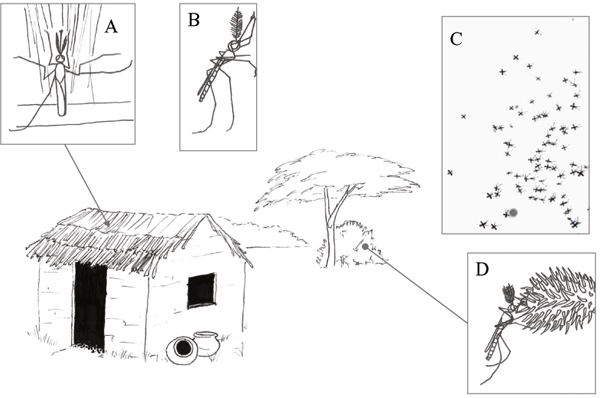Anopheles gambiae,
African malaria mosquito
Brief facts
Anopheles mosquitoes can be distinguished from other mosquitoes by the palps, which are as long as the proboscis, and by the presence of discrete blocks of black and white scales on the wings. Adult Anopheles can also be identified by their typical resting position: males and females rest with their abdomens sticking up in the air rather than parallel to the surface on which they are resting.
One important behavioral factor is the degree to which an Anopheles species prefers to feed on humans (anthropophily) or animals such as cattle (zoophily). Anthrophilic Anopheles are more likely to transmit the malaria parasites from one person to another. Most Anopheles mosquitoes are not exclusively anthropophilic or zoophilic. However, the primary malaria vectors in Africa, A. gambiae and A. funestus, are strongly anthropophilic and, consequently, are two of the most efficient malaria vectors in the world.
Female mosquitoes of the genus Anopheles, including A. gambiae, are main vectors for transmitting malaria parasite, Plasmodium falciparum, which is responsible for the death of more than a million of people annually. A. gambiae species parasitize humans almost exclusively and are allegedly attracted to smelly feet.
Of the approximately 430 known species of Anopheles, only 30-50 transmit malaria in nature. The successful development of the malaria parasite in the mosquito (from the gametocyte stage to the sporozoite stage) depends on several factors. The most important is ambient temperature and humidity (higher temperatures accelerate the parasite growth in the mosquito) and whether the Anopheles survives long enough to allow the parasite to complete its cycle in the mosquito host (from 10 to 18 days).
The Anopheles mosquitoes are also vectors of O'nyong-nyong virus as well as parasitic nematodes that cause lymphatic filariasis, a disfiguring and incapacitating disease. They are also competent to transmit heartworms. Detailed Treermation about ubiquitous parasites - heartworms, Dirofilaria immitis at MetaPathogen.
Most Anopheles mosquitoes are crepuscular (active at dusk or dawn) or nocturnal (active at night). Some Anopheles mosquitoes feed indoors (endophagic) while others feed outdoors (exophagic). After blood feeding, some Anopheles mosquitoes prefer to rest indoors (endophilic) while others prefer to rest outdoors (exophilic).
Life cycle of A. gambiae
Life cycle can be completed in 1.5-3 weeks.
Egg
Mosquitoes mate during flight. Once mated, the female searches out a blood meal. Then, she seeks out a resting place to digest her meal. Once the meal has been digested, the ovaries develop and the female lays eggs (typically in 2 days after sufficient bloodmeal). Usually female lays a batch of 50-200 eggs in shape of floating raft on the surface of the water at night.
Embryo
Hatching
In tropical temperatures the eggs hatch in two to three days.
Larval MeSH
All larval stages are aquatic; collectively they take a minimum of 4 days to complete. The larvae lie just below the surface of the water and feed on microorganisms, and, typically, after 7-14 days (9 days in controlled environment at 28 degrees Celsius) they turn into pupae during a five-minute process. Anopheles are unlike Culex and Aedes larvae since they do not have a breathing tube, they must lie parallel to the water surface in order to get a supply of oxygen through a breathing opening.
1st instar larva
1st molting
2nd instar larva
2nd molting
3rd instar larva
3rd molting
4th instar larva
4th molting
Pupa MeSH
Pupal stage takes 2 days (at 28 degrees Celsius) to several weeks to complete depending on temperature; the pupa is comma-shaped and is the least active stage of the Anopheles lifecycle. After two to four days the pupa metamorphoses into an adult mosquito.
Newly eclosed
Very young adult mosquito; the adults emerge during late evening and are able to fly within minutes.
Adult
The adult stage is when the female acts as malaria vector. Both male and female mosquitoes feed on nectar and damaged fruits, but only females feed on animal blood to provide proteins for their eggs. The adult mosquito survives for between one week (in natural habitat) and one month (in captivity).
